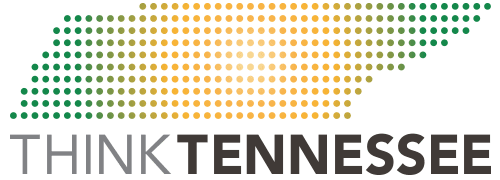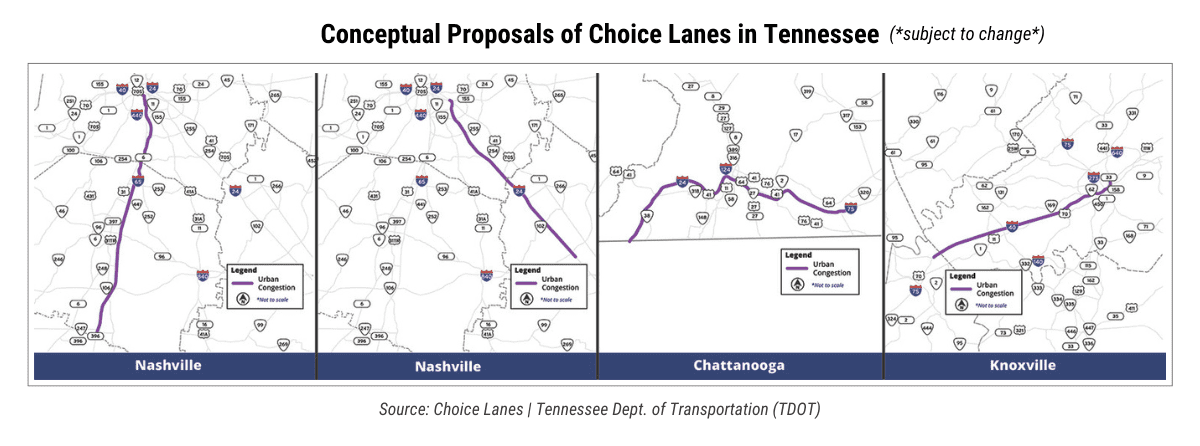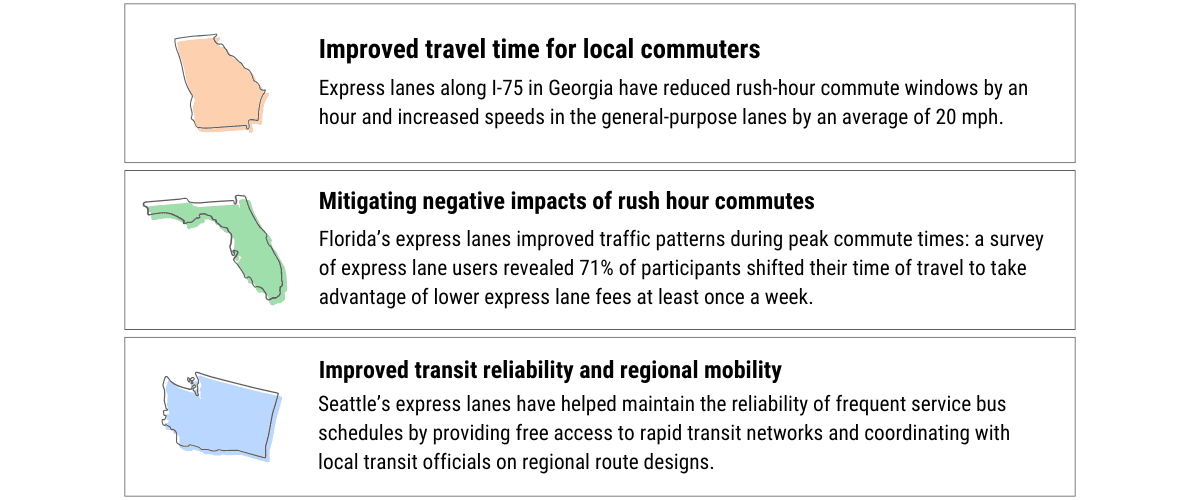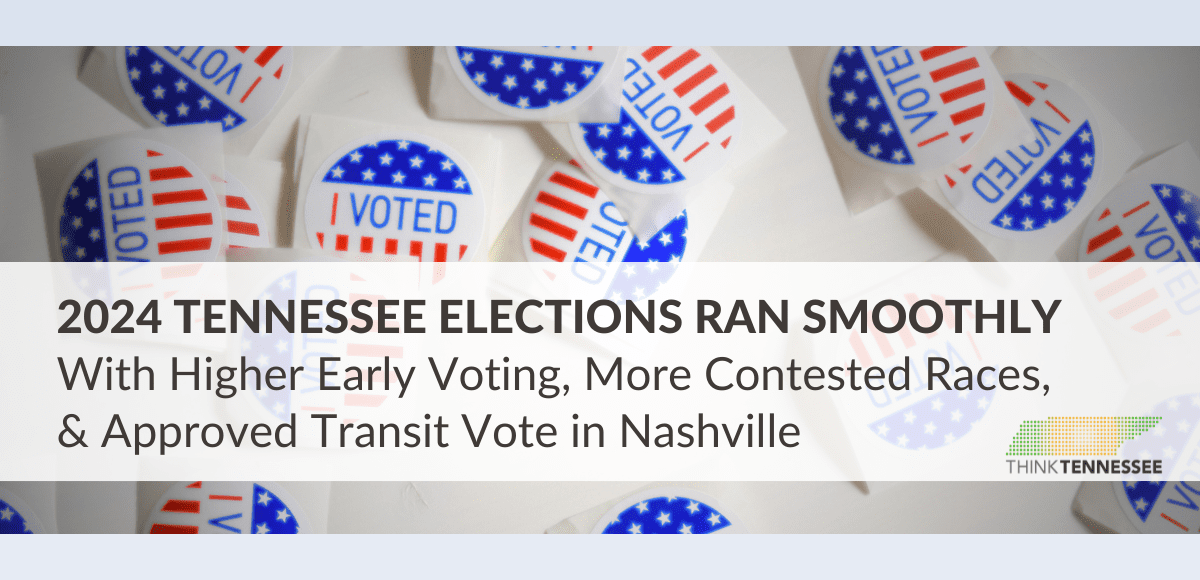As part of an initiative to relieve congestion, Tennessee will begin building choice lanes in Nashville, with potential projects in other major Tennessee cities following shortly. But what will these choice lanes look like, and how do they work? Why is the first project in Nashville, and how long will it take to complete? How will this impact people at different income levels and demographic groups? What valuable lessons can we learn from other states? We explore these questions below by sharing updates on the Nashville project and discussing issues of affordability and oversight.
Key Takeaways
- The first choice lane will be built between Nashville and Murfreesboro, with other projects in Chattanooga and Knoxville still being evaluated. Construction is not scheduled to begin in Nashville until 2027, and TDOT is still in the process of finding a private partner.
- Express lanes — which operate similar to choice lanes in other states — have reduced travel times, improved traffic flow, and supported transit reliability.
- Express lanes can benefit all demographic groups, with lower-income users regularly benefiting from express lanes regardless of fluctuating pricing levels.
- Tennessee officials can improve the success of choice lanes by considering a toll rate fee cap, implementing regular oversight of performance and financial indicators, adapting pricing policies to changing traffic patterns and user behavior, and allocating a portion of revenue to support multimodal transportation alternatives.
Tennessee’s Choice Lanes Are Intended to Generate Revenue and Mitigate Congestion in Urban Areas
When the IMPROVE Act passed in 2017, it included a $0.06 increase in the statewide gas tax to fund 962 projects in all 95 counties (273 of which were non-bridge related projects). Despite this increased funding, TDOT still has 134 incomplete or unplanned projects (out of the original 962) and faces an estimated $26 billion budget shortfall to address congestion-related projects statewide by 2040. In response, the General Assembly passed the 2023 Transportation Modernization Act (TMA) to provide a one-time cash infusion of $3.3 billion and to authorize more efficient delivery models, increase revenues through choice lane user fees and electric/hybrid vehicle fees, and leverage private investment through public-private partnerships.
Choice lanes, often called “express” or “managed” lanes, are separate, additional lane(s) that drivers pay a one-time, per-use fee to access. Access is restricted to paying or eligible vehicles with the goal of achieving faster traffic flow in both the choice lane and general-purpose lanes. This access fee varies based on the time of day and overall traffic conditions. Choice lanes are different from toll roads, as toll roads require all road users to pay a toll and typically prioritize revenue collections over traffic management.
Tennessee’s First Choice Lanes Are Still in the Beginning Phases
Choice lanes are typically designed to relieve congestion along major corridors, and based on TDOT congestion studies, choice lanes are being prioritized in Middle and East Tennessee. West Tennessee is anticipated to receive a similar level of investment through the I-55 bridge project over the Mississippi River.
The I-24 corridor connecting Nashville to Murfreesboro has been identified as the first choice lane project due to severe traffic bottlenecks and projected population and employment growth along this corridor. This is the first time the State of Tennessee has done a public-private partnership. As a result, the project timeline will be longer than usual as TDOT navigates a new project delivery system. Based on similar projects in other states, the total project timeline is likely 6-10 years from conception to completion, with construction scheduled to begin sometime in 2027, and the project expected to open to the public in the 2030-2033 timeframe.
In March or April 2025, Middle Tennesseans can expect more public input opportunities on environmental assessments, and much of 2025 will be spent on soliciting proposals and input from potential private partners on project design, management, and delivery. TDOT has stated they will continue to promote public education opportunities on user fees and receive community feedback during this same period.
[View TDOT’s I-24 Choice Lanes Project Page for the most up-to-date project information]
Choice Lanes Have Worked in Other States
Managed express lanes have been implemented in 11 states (Colorado, California, Florida, Georgia, Maryland, Minnesota, North Carolina, Texas, Utah, Virginia, and Washington) and have shown numerous benefits, including:[1]
While choice lanes have demonstrated benefits, these projects can face criticism for issues of affordability and equity — sometimes called “Lexus lanes” due to the perception that only high-income drivers could afford to pay the user fee. However, several studies show that well-designed managed lanes can address these concerns:
- Express lanes serve all income levels and demographics, and are not just for wealthy drivers.
-
- A study of express lane users in Minnesota showed no significant income difference between those who used the express lanes and those who normally commute in general purpose lanes. Users came from all income classes and demographic groups.[2]
-
- Lower-income commuters use express lanes differently to achieve better results.
-
- In a University of Washington study, higher income groups used express lanes more often, obtaining a larger overall share of the benefits per user. However, lower income users were found to obtain higher net benefits per trip (defined as the value of time savings minus the cost of the toll paid) than higher income groups. This is because they used express lanes more strategically to meet specific needs such as getting to work on time or picking up children from school or daycare.
-
Tennessee Can Take Steps to Create Better Outcomes for All Tennesseans
There are a number of best practices Tennessee can consider that will help achieve equitable project outcomes, protect the public interest, and support better transportation options for all Tennesseans.
- Reasonable Fee Caps: TDOT could implement reasonable fee caps that are responsive to traffic performance to preserve free-flowing speeds and protect middle- and low-income drivers’ access to choice lanes.
- Texas and Maryland, for example, utilize a dynamic pricing model to respond in real-time traffic flows but implemented a soft cap on toll rates of $0.75 per mile indexed to inflation. This cap is considered “soft” because it authorizes temporary controlled rate increases above the cap when traffic performance falls below optimal levels. This model preserves both reasonable pricing and traffic reliability.
- Regular Performance Audits of Private Partner(s): Tennessee legislative officials and agencies could regularly monitor the private partner user fee collections, revenue management, debt financing progress, and overall facility maintenance efforts to protect the public interest.
- Following increases in toll rates of more than 160% over four years and numerous safety issues, the Texas Department of Transportation ended its contract with private operators of SH 288 with the goal of providing more reasonable rates for express lanes users and to retain affordability. Regular oversight of the operator’s key performance indicators helps identify when policy corrections are needed and protect public investments.
- TMA Board Sets and Reviews Pricing Policies: The Transportation Modernization Board could regularly assess, review, and set pricing policies for different choice lane projects (independent of contract agreements with private operators). Analyzing pricing patterns and user behavior, informed by regular reporting requirements, can promote transparent and consistent pricing levels.
- SR-91 Express Lanes in Orange County, California utilizes a time-of-use based variable tolling schedule that is updated every few months by its oversight board, which helps to respond to shifts in traffic behavior and maintain the necessary levels of revenue to meet financial obligations.
- Choice Lane Revenue for Multimodal Transportation Options: A certain percentage of revenue generated by choice lanes could be allocated for multimodal transportation options such as transit, walking, and biking in the same communities in which choice lanes operate. This provides residents with viable, convenient options if they choose not to travel in choice lanes and further maximizes the project’s impact on congestion reduction.
- Minnesota requires one-half of all excess revenue from I-394 express lanes be transferred to the local council for bus transit services within the express lane’s travelshed.[3]
- Improve Compatibility with Transit to Benefit Commuters: TDOT could consider commuter programs that encourage compatibility and cooperation with local transit networks, offering more transportation alternatives and further maximizing congestion mitigation efforts.
- Georgia’s State Road & Tollway Authority offers meaningful alternatives by allowing residents who use transit to earn toll credits for days when they need to drive automobiles.
Choice lanes will continue to move forward in Middle Tennessee, but the project will not be completed for some time. Transportation officials should look for opportunities to address concerns around affordability and equity, maximize the project’s impact on congestion, and improve transportation options for all Tennesseans.
_________________________________________________________________
ENDNOTES
[1] See OBenberger, Jon. “Managed Lanes.” Public Roads – FHWA 68, no. 3 (2004). https://highways.dot.gov/public-roads/novemberdecember-2004/managed-lanes. AND Riggall, Hunter. “Georgia Looks to Express Lanes, Commuter Buses to Solve Traffic.” Governing, October 15, 2021. https://www.governing.com/community/georgia-looks-to-express-lanes-commuter-buses-to-solve-traffic. AND Stride BRT Community Outreach Team. “Stride Bus Rapid Transit.” SoundTransit, n.d. https://www.soundtransit.org/system-expansion/stride-bus-rapid-transit.
[2] For more information on the demographics of express lane users, see U.S. Department of Transportation – Federal Highway Administration. “Income-Based Equity Impacts of Congestion Pricing—A Primer,” December 2008. https://ops.fhwa.dot.gov/publications/fhwahop08040/cp_prim5_04.htm. See also Hall, Jonathan. “High-Occupancy Toll Lanes: Their Distributional Impact and Effect on Congestion.” In International Transport Forum Discussion Papers, Vol. 2020/07. OECD Publishing, 2020. https://doi.org/10.1787/04525828-en.
[3] There are a variety of case studies on how revenues generated by express lanes can be dedicated to public transportation or alternative multimodal options. See “Transit and Congestion Pricing: A Primer.” U.S. Department of Transportation – Federal Highway Administration, 2009. https://ops.fhwa.dot.gov/publications/fhwahop09015/cp_prim7_00.htm









